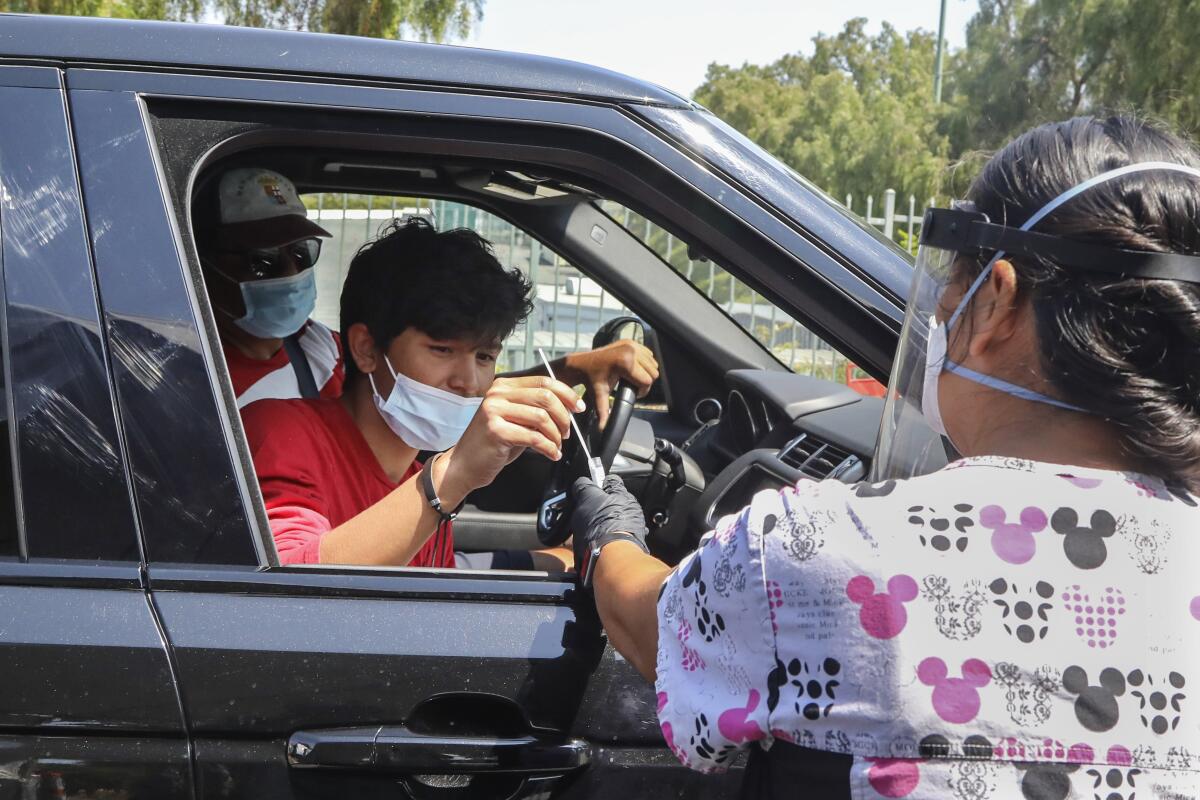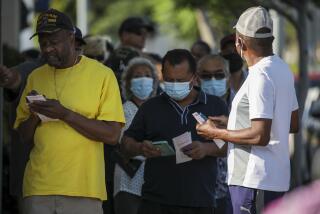California’s deadliest month of the COVID-19 pandemic is August

- Share via
August was the deadliest month of the COVID-19 pandemic in California, even as the state makes steady progress in reducing infections, hospitalizations and deaths, data show.
This month, California has reported 3,745 deaths connected to COVID-19, an 18% increase over July, a Los Angeles Times analysis found.
The news comes as California tops 700,000 coronavirus cases, the most in the United States. But adjusted for population, the Golden State’s case count is dwarfed by 20 other states, including Southern hot spots such as Florida, Louisiana and Mississippi, according to federal data.
Despite August’s grim fatality milestone, new data released by California officials and analyzed by The Times show that by practically every measure, the state’s coronavirus situation is slowly improving.
Infection and hospitalization rates have fallen steadily for more than a month. The average number of daily deaths is declining, too, which may be the product of tightened restrictions after a surge of COVID-19 cases around Memorial Day.
If the pattern holds, and Californians continue to observe social distancing protocols and wear face coverings, fatalities should continue to decline, officials say.
Hospitalizations peaked in late July, when the state reported 7,170 patients being treated for COVID-19. In August, hospitalizations have dropped steadily, hitting 3,940 this week — the fewest since late June, and a decline of 45% from a month ago.
The seven-day average of daily deaths in California is at its lowest point this month, a Times analysis found. The state is reporting an average of 112 deaths per day, a 14% decline from last week and a decrease from 133 daily deaths at the start of August.
This weekend, Gov. Gavin Newsom launched a new plan to slowly bring back the California economy, which has been battered by months of forced pandemic closures.
That included a green light for some businesses to open statewide, regardless of how well the local area is coping with the virus. Hair salons and barbershops are allowed to reopen, as are stores and shopping malls, limited to 25% capacity.
At South Coast Plaza, the upscale shopping mall in Costa Mesa, company officials said more than 100 stores had reopened this week, with outdoor dining, takeout and curbside pickup available at more than 20 restaurants.
It’s not life as usual at the mall, though. Face coverings are required, and valet parking, drinking fountains, stroller rentals, wheelchair rentals and carousels are still unavailable.
The center closed in mid-March and remained shuttered until June 11. After welcoming back long lines of shoppers, the mall was forced to close again about a month later, after COVID-19 cases surged and California reimposed many business restrictions.
Newsom’s new system scraps the state’s “watchlist” and instead sorts counties into four categories based on their progress fighting the virus. Before businesses can reopen and group activities can resume, counties must show proof of consistent progress.
The majority of the state is still classified as “Tier 1,” and is subject to the most restrictive policies on gatherings and business operations. That includes Los Angeles, Orange, Ventura, Riverside and San Bernardino counties, where few businesses are open for indoor operations.
Counties that have made more progress against the virus, including San Francisco and San Diego, have been classified as “Tier 2,” with some nonessential businesses allowed to operate indoors with reduced capacity.
The hardest-hit areas of California are still in the Central Valley, where five counties are still seeing infection rates greater than 400 cases per 100,000 residents, according to The Times’ coronavirus tracker.
The rate of positive COVID-19 tests in Los Angeles County fell to 5% this week, the lowest level since mid-May, said Dr. Muntu Davis, the county’s public health officer. And the daily transmission rate among Latino residents, who have been disproportionately harmed by the virus, is at the lowest point since mid-May, Davis said.
“This is good news, but we’re still seeing way too many cases,” Davis said. The testing rate, he said, is still “indicative of wide spread.”
He cautioned that a low testing rate can surge upward with little notice, as it did in June and July. After an initial dip in positive results in May, Davis said, infections surged as “we saw many people in crowds” at reopened businesses and over Memorial Day weekend.
Officials have voiced concern about the possibility that infection rates could similarly spike after Labor Day weekend, which is expected to hit in the middle of a triple-digit heat wave in Los Angeles County.
“It’s likely going to be a hot weekend, so be sure to take precautions to avoid the hottest part of the day and keep cool,” Davis said. He recommended visiting a hiking trail or having a picnic in the early morning or evening.
Davis advised residents to avoid gathering with anyone not in their household unit, and to wear a face covering or mask in public places. He also advised residents to avoid sharing cups, utensils and plates; to avoid crowded areas; and to be flexible, in the event that an area you’d planned on visiting is too crowded.
More to Read
Sign up for Essential California
The most important California stories and recommendations in your inbox every morning.
You may occasionally receive promotional content from the Los Angeles Times.











